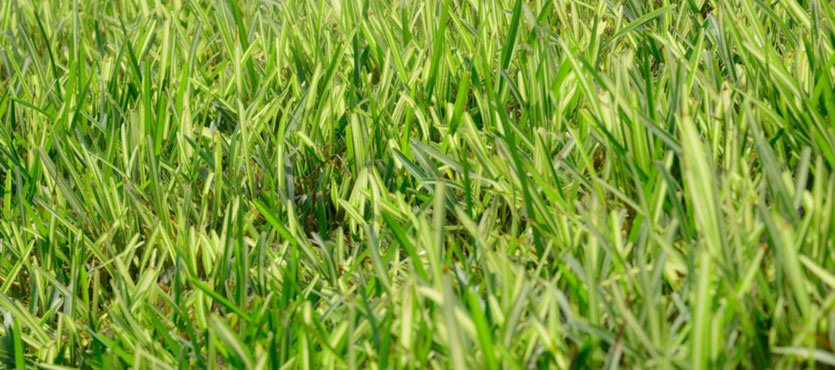As the most popular grass in the region, St. Augustine grass is a favorite across the deep south. A tropical grass, Stenotaphrum secundatum (St. Augustine grass here in the U.S.) is often the turf of choice in warm humid climates. St. Augustine grass offers a course texture that is well suited for lawns at homes or businesses. Because it has a low tolerance for wear, it is rarely used on sports fields or golf courses. This grass is started vegetatively, primarily by sod.
The Advantages of St. Augustine Grass
St. Augustine grass presents in shades from light to dark green and grows well in the south, particularly along the coasts due to its salt tolerance. It is also shade tolerant making it an ideal choice for shady lawns. As mentioned St. Augustine is most easily established via sod, which needs to be watered carefully as the roots become take hold. It can also be started from plugs and sprigs (stolons). The stolons (also known as runners) sprout and root in which the “mother” clones to form the “daughter” plant and spreads. St. Augustine grass becomes dormant if soil temperatures go below 55 degrees, but in soil above 60 degrees year-round, it remains green.
The Disadvantages of St. Augustine grass
St. Augustine grass, as mentioned, has low wear tolerance though it holds up well in the normal traffic of home lawns. For some home and business owners, the coarse texture is less than pleasing. St. Augustine grass is also not drought tolerant and requires irrigation to remain green. St. Augustine Decline (SAD) (a virus) and chinch bugs are damaging pest for this grass.
How to Care for St. Augustine Grass
St. Augustine grass is susceptible to “looping” in which runners grow on the surface or in the air and are not attached to the soil. It is thought to be the result of mowing too low, heavy application of pre-emergent in spring, or soil nutrient deficiency. In some cases, looping is temporary and will correct itself, in others, you may need to try vertical mowing to solve the problem.
Irrigation is key for St. Augustine varieties which need the soil to be deeply wetted to three or four inches in the early morning hours. Proper watering promotes root growth and longevity. You’ll know you need to water when your grass appears blue-green in color or your footprints don’t quickly go away when walking on the lawn.
Most St. Augustine varieties prefer a mowed length of three to four inches, though Amerishade can be cut to around two inches. Sharp blades are essential in mowing as dull blades tend to shred the grass and cause browning.
St. Augustine grass needs fertilization – four to five pounds nitrogen per 1,000 square feet annually for established lawns. For lawns being started, fertilization needs are one-pound nitrogen per 1,000 square feet each month while growing. Too much fertilizer will encourage insect, disease, and thatch problems.
The main insect issue for St. Augustine grass is the chinch bug, which pierces the grass and sucks away the juice, allowing its saliva to poison the grass. Typically, chinch bug damage occurs in the spring. Insecticides are available, though some chinch bugs have developed their resistance. Other insect pests are cutworms, grub worms, grasshoppers, sod webworms, and mole crickets. Biological deterrents like Bacillus Thuringensis and Mach 2 with halofenozide are effective at targeting pupation stages.
Common diseases affecting St. Augustine Grass are take all root rot, brown patch, grey leaf spot, and often occur during humid summer weather. Bayleton Fungicide, Daconil, and others can help as can ensuring your soil is well-drained to avoid waterlog.
Note: When considering the use of insecticides or fungicides, be sure to read labels and directions carefully before making your purchase – particularly regarding safety for yourself, your family, and your pets.
Finally, thatch (an organic layer developing between the soil and grass) is another issue for St. Augustine grass. It can be caused as a result of over-fertilization, soil pH problems, or over-watering. Because thatch is acidic, applying agricultural limestone will reduce acidity and help prevent thatch development. Core aeration can also help opening up the soil and allowing air and water to reach the roots. Vertical mowing can help remove thatch as can a top dressing of organic matter.
Xtreme Landscaping is ready to help you care for your St. Augustine grass and handle any issues you are facing in keeping it healthy and strong all year long.

